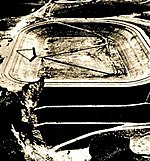Wich Stand

Wich Stand was a '50s-style coffee shop restaurant and diner in Los Angeles, California, featuring a tilting blue roof and 35-foot spire (11 m), designed by architect Eldon Davis.The Wich Stand had two locations in the Los Angeles area. One of the buildings still exists at the intersection of Slauson Avenue and Overhill Drive in View Park-Windsor Hills, an unincorporated affluent neighborhood of Los Angeles County near City of Inglewood that is encircled. It was known for its dart neon sign. A food critic said its "plunging dart of a sign keeps it from spinning off into space," and it's a surviving preserved examples of Googie architecture, according to The Los Angeles Times.The other was located within City of Los Angeles proper at the Northwest corner of Figueroa Street and Florence Avenue (as listed on menu and matchbook cover), which preceded the one "on the hill."
Excerpt from the Wikipedia article Wich Stand (License: CC BY-SA 3.0, Authors, Images).Wich Stand
West Slauson Avenue,
Geographical coordinates (GPS) Address Phone number Website Nearby Places Show on map
Geographical coordinates (GPS)
| Latitude | Longitude |
|---|---|
| N 33.9886 ° | E -118.3545 ° |
Address
Simply Wholesome
West Slauson Avenue 4508
90043 , Ladera Heights
California, United States
Open on Google Maps










